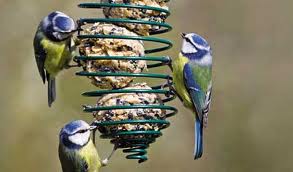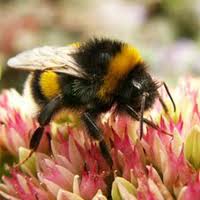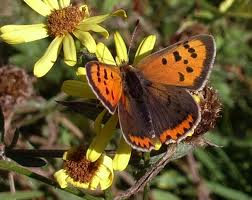





Once you have finished planning your wildlife garden, it is time to start on practical tasks, such as choosing plants to attract specific creatures, buying and planting native plants and creating special habitats. All the techniques you will need in order to simulate a woodland edge, a hedgerow, a wildflower meadow or a wetland are explained here, as well as how to adapt existing garden beds and borders to maximize the numbers of insects, birds and animals visiting them.
 Omnivorous birds feed on a wide range of different foods, which means that there is usually plenty for them to eat whatever the time of year. They include: the blue tit, which eats insects, seeds and nectar; the house sparrow, which likes seeds, buds and insects; the chaffinch, which eats seeds, weeds, caterpillars and even spiders; the blackbird, which eats insects, fruit and earthworms; and the robin, which likes insects, fruit, worms and snails. Other members of this group are the jay, which has a varied diet that can include small mammals; the somewhat less popular jackdaw, which raids other birds’ nests for their eggs; and finally the magpie, which eats almost anything, including seeds, fruit, snails, slugs, spiders and carrion.
Omnivorous birds feed on a wide range of different foods, which means that there is usually plenty for them to eat whatever the time of year. They include: the blue tit, which eats insects, seeds and nectar; the house sparrow, which likes seeds, buds and insects; the chaffinch, which eats seeds, weeds, caterpillars and even spiders; the blackbird, which eats insects, fruit and earthworms; and the robin, which likes insects, fruit, worms and snails. Other members of this group are the jay, which has a varied diet that can include small mammals; the somewhat less popular jackdaw, which raids other birds’ nests for their eggs; and finally the magpie, which eats almost anything, including seeds, fruit, snails, slugs, spiders and carrion.
Many birds, like the familiar swallow, are insect-feeders, deriving all or most of their food either from catching insects on the wing (in the case of swifts, swallows, house martins and flycatchers), by digging into the soil (green woodpeckers), or by collecting insects from the plants on which they are feeding (wrens, goldcrests and chiffchaffs). The more insect-attracting plants you grow in your garden the more insect-feeding birds will appear. The garden pond also provides mosquitoes and midges for swifts and swallows. A wildflower meadow is another insect-rich source for many birds, including wagtails. Most of these birds rarely visit bird tables, although in winter a few will take fallen seeds and crumbs.
The goldfinch is an attractive small bird with a red face and yellow bars on its wings; teasels and thistles will readily attract it to the garden, as will I andelions left in the lawn to go to seed. Like the tree sparrow, brambling, greenfinch and crossbill, its diet consists entirely of seeds, whereas several other garden birds, like the siskin, linnet, dunnock, redpoll, nuthatch, great tit and reed bunting, relish seeds but also include insects in their diet, so that they do not go hungry when seeds are less available in spring and early summer. Another frequently seen garden bird, the bullfinch, likes seeds and insects but its real love is fruit buds, which makes it more of a pest than a welcome visitor. Most of these birds will visit bird tables in the winter for seeds and grain.
Fruit-eating birds are easy to attract into your garden either by leaving windfall apples and other fruit on the ground in winter or by planting a range of plants that produce berries, like rowan trees and fruiting viburnums. Fruit-eating birds include the redwing and garden warbler, which eat only fruit, and fieldfares, mistle thrushes and blackcaps, which have fruit as a major part of their diet but may also eat seeds or insects. Several of the omnivorous birds, including blackbirds, robins, collared doves and pheasants, will happily eat fruit when it is available but eat a range of other food when the fruit season is over. Birds are attracted by the colour red, so red and red-orange berries are always eaten first, with white or yellow ones being left until late in winter.
 There are several different species of bumblebee, which have thicker, hairier bodies than honeybees. They forage for food, pollinate flowers and sting predators like the honeybees and live in colonies with workers, drones and a queen bee. However, the colonies are much smaller and the bees do not survive the winter, leaving just the young queens hibernating underground to form new colonies in the spring.’ The largest is the buff-tailed bumblebee, with a yellow-and-black body and a buff-coloured tail. Other frequent visitors are the garden bumblebees, with white tails, the large red-tailed bumblebee (black body and red tail), the meadow bumblebee (red tail but yellow-and-black stripes) and the common carder bee (buff all over).
There are several different species of bumblebee, which have thicker, hairier bodies than honeybees. They forage for food, pollinate flowers and sting predators like the honeybees and live in colonies with workers, drones and a queen bee. However, the colonies are much smaller and the bees do not survive the winter, leaving just the young queens hibernating underground to form new colonies in the spring.’ The largest is the buff-tailed bumblebee, with a yellow-and-black body and a buff-coloured tail. Other frequent visitors are the garden bumblebees, with white tails, the large red-tailed bumblebee (black body and red tail), the meadow bumblebee (red tail but yellow-and-black stripes) and the common carder bee (buff all over).
Honeybees live in organized colonies or hives. A single fertile queen bee lives in the hive and lays eggs, which are then fed and guarded by thousands of sterile females, called worker bees, and a few hundred male drones. The nest is filled with an intricate honeycomb made from tree resin and water, and the spaces are filled with eggs, pollen or honey, made from flower nectar. The eggs develop into larvae, which are fed on pollen and honey until they emerge as bees. At the end of the summer, honey is stored for winter food during hibernation. Some colonies of wild bees live in hollow trees or cavity walls, and hives of honeybees are kept by farmers for the production of honey. Honeybees are major pollinators of wild flowers and fruit trees.
There are nearly 250 different kinds of hoverfly, which get their name from their habit of hovering over plants before landing to take nectar and pollen. Most of the species are mimics and take on the colouring of wasps, honey- or bumblebees to provide a defence from predators. However, they are all completely harmless, having no sting, and use then protective colouring and darting speed to keep out of danger. They are very useful insects to attract into the garden because their slug-like larvae feed on aphids, some managing to consume up to 800 aphids in a two-week larval period. They are also useful pollinators. Hoverflies have short tongues and favour flowers with exposed pollen and nectar, such as plants of the carrot and daisy families.
There are many different types of ladybird, of which some are red with black spots, others are yellow with black spots, and yet others black with yellow spots. The numbers of spots vary but the most common are the seven-spot ladybird and the smaller two-spot ladybird. Their bright colour warns predators that they are poisonous and should be left alone. They are a friend to gardeners because all ladybirds are voracious aphid-eaters, as are their slate-blue, rather ugly, larvae. Ladybirds lay their eggs on aphid-infested plants so that when the larvae emerge there is ample food for them. The adults hibernate in cold weather and search out cracks in woodwork in which to spend the winter. Hundreds will huddle together awaiting spring.
Early entomologists gave the name of ‘aristocrats’ to the largest and most colourful butterflies in the countryside and then gave them aristocratic names like purple emperor, red admiral and painted lady. Most of them hibernate as adults during the winter, although the red admiral, painted lady and Camberwell beauty may not survive cold winters. The small tortoiseshell is the most often seen, followed by the red admiral and the peacock. The red admiral, small tortoiseshell, peacock and comma all lay their eggs on stinging nettles, which are the caterpillars’ food plant. The larvae of the white admiral feed on honeysuckle and their low numbers are now increasing, whereas the purple emperor, which feeds on sallow trees, is now rarely seen.
 These are all small butterflies and mostly flyers; the blues and coppers have bright-coloured wings, whereas the hairstreaks are more muted, usually with a white-line ‘hairstreak’ on the underside of the wings.
These are all small butterflies and mostly flyers; the blues and coppers have bright-coloured wings, whereas the hairstreaks are more muted, usually with a white-line ‘hairstreak’ on the underside of the wings.
The blues and coppers are found in grassland, where bird’s foot trefoil, kidney vetch and dock provide them with food for their caterpillars, and the hairstreaks in woodlands and glades, where their caterpillars feed on blackthorn, oaks and elms. The adult butterflies of the common and holly blue and the small copper are often seen in gardens seeking nectar. Creating a wildflower meadow with clovers and vetches will encourage butterflies. The white-letter hairstreak will visit brambles and privet.
These butterflies are predominantly white or yellow and most of their caterpillar food plants are in the cabbage and pea families — the Brassicaceae and Papilionaceae. An exception is the brimstone, whose caterpillars will feed only on buckthorn and whose bright yellow wings may have given the name butterfly to this group of insects.The brimstone hibernates as a butterfly, whereas the others mostly overwinter as chrysalises. Most of the group have black markings on their wings, which act as a warning to predators that the wings are poisonous. The clouded yellow, brimstone and orange-tip butterflies are all welcome visitors, but perhaps not the large and small white butterflies, the cabbage whites, whose caterpillars devour cabbage leaves.
The brown butterflies all have false ‘eyes’ on either the upper or lower surface of the wings, which are intended to confuse predators. All but the marbled white are brown in colour with occasional orange markings. They spend the winter as caterpillars eating grass; the adults emerge during the summer and are mostly to be found in grassland and pasture. The gatekeeper and meadow brown are regular garden visitors for nectar, and creating a wildflower meadow may encourage other browns.
The fritillaries inhabit woodland glades; they have orange or brown wings with speckled markings. The caterpillars of several fritillaries depend on violets for their food plant, and a number of the fritillaries are in serious decline.
Frogs, toads and newts are all amphibians and need water for breeding and for part of their life cycle. Eggs are laid in the water, and the first stage of life, the tadpole, swim, in the water before developing into an adult, which comes out onto dry land. Frogs are frequent visitors to garden ponds because their natural habitats, field ponds, have become filled in or polluted. During the summer they will travel considerable distances in search of water. Frogs have a smooth skin and long legs with bold markings. They are useful garden inhabitants because the tadpoles feed on algae and the adult frogs eat insects, slugs and snails. The usual garden frog is the common frog, but other species, such as the marsh frog and the edible frog, also occur.
Like frogs, toads hibernate in winter, finding a damp spot under stones or logs not far from their breeding ponds. In the early spring, the toads awaken and migrate back to the pond, often in large umbers, and often climbing walls and crossing busy roads on the way, during which many are killed by traffic. Toadspawn is produced in long double strings of eggs, which are often wrapped around water plants. The tadpoles live in the pond before emerging as adult toads to live on dry land. Toads tend to be solitary and live under logs or vegetation during the day, emerging at evening to feed on insects and small animals. The usual toad found in or near garden ponds is the common toad; a slightly smaller and faster one is the natterjack.
Newts are not often seen out of water (they spend most of their time in the pond and even hibernate in the mud at the bottom) but they will emerge to hibernate under rockery stones if these are placed near the pond. The smooth newt is the most common species and is found in most areas; the smaller palmate newt is found in moorlands and heaths; and the great crested newt spends most of its time in the water. The latter is now very rare and protected by law. Newts lay their eggs singly, attached to a submerged leaf, which is wrapped around the egg for protection. The tadpoles have external gills and the tadpole stage is longer than in frogs or toads. Newts emerge in the evening to feed on insects and slugs.
Another inhabitant of garden ponds is the dragonfly, which lays its eggs just below the surfke of the water. The eggs hatch out as larvae, known as nymphs; these may spend two to five years in the pond before climbing out up the leaves or stem of a water plant to shed their skin and emerge as dragonflies. The adults feed on midges by swooping over the water to catch them in flight. The largest dragonfly is the emperor, with a wingspan of 10cm (4in) and a bright blue abdomen in the male and green in the female. Other dragonflies are separated into hawkers, which have long wings and thin bodies and restlessly patrol their territory, and darters, which have thicker bodies and spend much of their time clinging to waterside vegetation.
Copyright © www.100flowers.win Botanic Garden All Rights Reserved